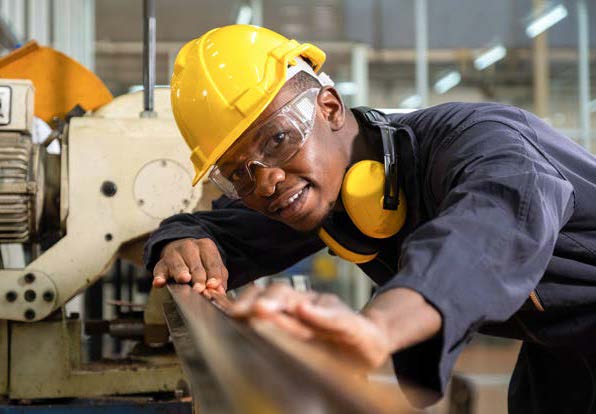- Perspective – August 2025
- NDE Advert
- GPS Round Up
- Sassda News : Sixty Minutes with Stainless Webinar: Full Report
- Sassda News : Tariffs with a Purpose
- EMV Africa Advert
- State of the Stainless Steel Nation
- Focus Feature
- Professional Profile – Craig Bateman
- Technical Case Study – Stainless Steel in Hydrometallurgy
- Member News – Astra Industrial Innovations
- Member News – African Sinks
- Market Intelligence – North Africa Rising
- Sassda News
- Member News
Standing Firm amid Energy, Policy, and Trade Pressure

South Africa’s stainless steel sector is under pressure from energy issues, policy uncertainty, and global trade shifts. Yet, as Sassda Executive Director Michel Basson explains, the industry is adapting by pushing back against unfair imports, exploring export growth, and calling for practical support in skills, infrastructure, and localisation...
South Africa’s economy continues to face pressure from energy insecurity, logistics constraints and policy uncertainty. How are these macroeconomic challenges impacting the local stainless steel value chain?
The local stainless steel industry remains constrained by energy issues, logistics challenges, and policy uncertainty. However, in some areas, the situation has improved over the past year. While electricity supply is less insecure at a national or generation level than in previous years, availability at the municipal level and the cost of electricity remain serious concerns. Although solar and other renewables have become viable for certain users, small and medium enterprises often find the cost of implementation beyond their reach.
Logistical bottlenecks at ports of entry continue to cause long lead times for importing and exporting materials and equipment. A positive development is Transnet’s slow but steady progress in rebuilding freight infrastructure, which could lead to more cost-efficient cargo transport and less congestion on roads.
Despite these challenges, the local industry has proven resilient and continues to adapt to both domestic and international market changes. Sassda remains committed to helping members navigate issues such as tariffs, the dumping of subsidised products, and will increasingly support exporters going forward.
Global trends such as trade protectionism, rising input costs, and shifting supply chains are reshaping industrial markets. What external factors are currently having the greatest influence on stainless steel demand and competitiveness in Southern Africa?
While global trade tools like tariffs and protectionism are not new, they have recently become far more disruptive. It’s important to understand that disruption doesn’t always mean damage. It often signals accelerated change and those who adapt quickly can emerge stronger.
However, the South African stainless steel industry has struggled to build a strong foundation over the past two decades, making it harder to respond to change. This is especially true for small and medium-sized fabricators, who are often at the mercy of bigger players engaged in global trade battles. Still, the industry remains adaptable, grounded in a pragmatic approach to change. For example, our recent tariff survey showed that while most members oppose blanket import tariffs, they support targeted tariffs on subsidised or inferior imported products.
With government signalling its commitment to industrialisation and localisation, where do you see the most immediate and realistic opportunities for stainless steel-driven growth, whether in public infrastructure, energy, transport, or water?
In the short term, growth will come from supporting local fabricators to become profitable in their current markets. For domestic producers, a level playing field against importers is essential. Developing these producers into efficient, competitive entities means shielding them from unfair competition. It’s crucial to determine whether competitors are winning on cost or simply on price, which may reflect government subsidies, lower quality, or other distortions.
Sassda will investigate such issues and act accordingly. Exporters also need support to become more competitive, and expanding into new markets will be a key Sassda focus. In the medium to long term, opportunities include developing new products, new applications for stainless steel, and replacing galvanised or coated mild steel where feasible. A potential game-changer remains a government backed nuclear build.
Investment in downstream processing and value-added manufacturing is often cited as a growth enabler. What are some of the practical barriers to unlocking this potential, and what kinds of public-private collaboration might help overcome them?
At a recent Sassda webinar, economist Dawie Roodt noted that the era of traditional factory work may be ending in developed economies. However, South Africa’s context is different. Job creation is vital, and many are willing to do any work available. This puts pressure on the industry to grow in
a way that creates value and jobs.
Barriers include low skill levels (not necessarily a lack of formal education) and slow or stagnant economic growth. Many blame government policies and misplaced labour regulations for limiting growth. Public-private collaboration can help drive job-creating projects. In particular, targeted import-replacement initiatives could unlock new fabrication opportunities and generate employment.
Skills development and workforce readiness remain persistent issues across the sector. How can businesses and industry bodies better align technical training with evolving needs in fabrication, design, and materials handling?
Skills development remains a key issue, but it’s not just about academic qualifications. Fabrication still relies on many manual skills that can’t be taught in a classroom. By formally identifying and structuring training for these skills, the industry can make a real impact.
Additionally, not all needed skills are technical and soft skills such as leadership, productivity, and management are just as important. Workforce readiness means having a well-rounded skill set that supports global competitiveness.
Looking ahead, which indicators such as policy shifts, project pipelines, or private sector sentiment, would give you confidence in a stronger stainless steel trajectory over the next 12 to 24 months?
While global trends are important, the local stainless steel industry’s stability will largely depend on how trade negotiations between the U.S. and South African governments unfold. Sassda hopes to secure stronger protections for local fabricators and new market access for exporters. As conditions shift rapidly, Sassda’s priority will be keeping members informed and helping the local industry stay one step ahead in a fast-changing environment.

